
Lorem ipsum dolor sit amet,
Gustav Mahler (1860-1911)

Dmitri Shostakovich
(1906-1975)
It was only late in its development that a way was found to turn the symphony inward, to make it a vehicle of introspection as personally revealing of its creator (and moving for the listener) as the masterworks of the chamber literature. The composer who joined together these public and private worlds to create works of an unprecedented expressive range was Gustav Mahler. Especially in the Ninth Symphony and Das Lied von der Erde, it is precisely this juxtaposition of the inner and outer man that gives his music much of its emotional power and incomparable poignancy.
The effect of Mahler on the music of Dmitri Shostakovich was pervasive. In the grandiloquent program symphonies (No. 7, Leningrad, for example) or the works with voices (No. 13, Babi Yar, and No. 14) or the large tonal canvases painted in starkly varied colors (No. 8 and No. 10), Shostakovich’s indebtedness to the Austrian master is striking.
The other major influence on Shostakovich was that of Igor Stravinsky. Stravinsky was almost a generation older than Shostakovich (a 24-year age difference) and his influence was simply so powerful on ALL Russian composers that it could not be escaped. In particular, Stravinsky’s use of rhythmic and metric displacement, which revolutionized 20th century music, can be found even in Shostakovich’s very first symphony:

The lovely flute solo waltz theme from the 1st movement of Symphony No. 1. Notice how the 3/4 waltz rhythm is offset by one quarter note, starting on beat two.
PROGRAM NOTES & COMMENTARY
Symphony No. 1 in F Minor, Opus 10
Genre: Symphonic; Country: Russia; Period: Early 20th Century
Completed in 1925; Premiered on May 12, 1926
with the Leningrad Philharmonic, conducted by Nicolai Malko
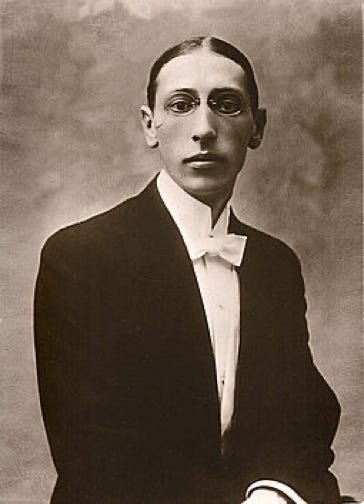
Igor Stravinsky (1882-1971)
Shostakovich was of course one of the supreme prodigies in the history of music, certainly along the lines of others like Mozart and Mendelssohn. As the table at right shows, Shostakovich was a force to be reckoned with from an early age!
The important thing to note here is that the Symphony no. 1 of Shostakovich was a much more polished and mature masterpiece than the first symphonies of Mozart, Mendelssohn, Schubert, and Glazunov. Between the completion of his Symphony no. 1 (1925) and the composition of his final Symphony no. 15 (1971), 46 years passed in which the composer focused on building the most important body of symphonies in the 20th century.
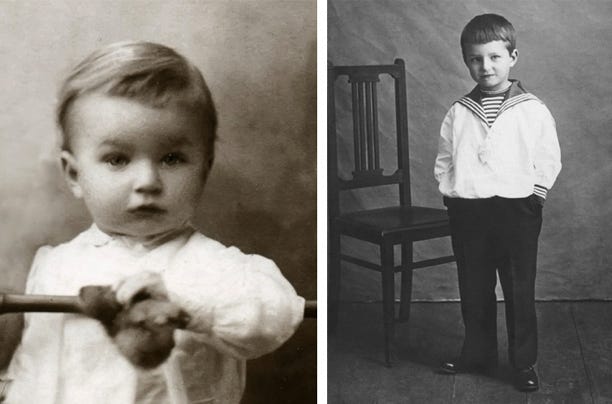
Shostakovich: an amazing talent at an early age!
First symphonies of selected composers, with their ages at time of composition:
Mozart: Symphony no. 1 (8)
Mendelssohn: Symphony no. 1 (15)
Schubert: Symphony no. 1 (16)
Glazunov: Symphony no. 1 (16)
Shostakovich: Symphony no. 1 (19)
Rimsky-Korsakov: Symphony no. 1 (21)
Dvorak: Symphony no. 1 (24)
Bernstein: Symphony no. 1 (24)
Prokofiev: Symphony no. 1 (25)
Stravinsky: Symphony in Eb (his 1st Symphony) (25)
Tchaikovsky: Symphony no. 1 (26)
Haydn: Symphony no. 1 (27)
Mahler: Symphony no. 1 (28)
Beethoven: Symphony no. 1 (30)
Schumann: Symphony no. 1 (31)
Walton: Symphony no. 1 (33)
Sibelius: Symphony no. 1 (33)
Borodin: Symphony no. 1 (34)
Vaughan-Williams: Symphony no. 1 (37)
Bruckner: Symphony no. 1 (42)
Brahms: Symphony no. 1 (43)
Dmitri Shostakovich’s First Symphony may be the greatest graduation project of all time. Composed at the age of 18 (completed at the age of 19), Shostakovich’s First Symphony was written to fulfill the graduation requirements of the Leningrad Conservatory (earning him the equivalent of a college music degree), and would take the international music world by storm the following year. But even more impressive were the enormous obstacles the young composer had to face in the years leading up to this momentous debut.
Shostakovich had been only 10 years old when the February Revolution ended over 400 years of Romanov rule. As a native of St. Petersburg, he witnessed firsthand the transformation of his country from a Tsarist autocracy to a Communist dictatorship between February and October 1917. These earth-shaking events would have powerful ramifications on his work as a composer, but at the time he was just a musically gifted boy eager to develop his talent—and to survive.
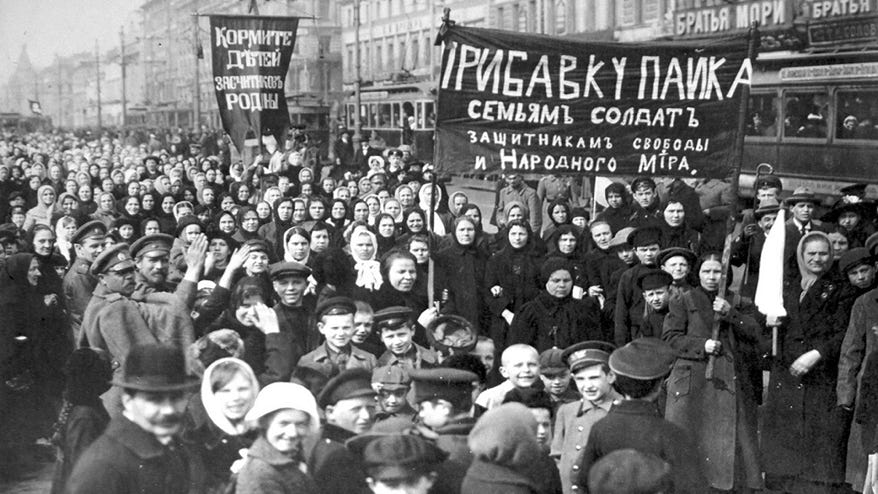
The Russian Revolution affected every aspect of Shostakovich’s life and career
He entered the Petrograd Conservatory at age 13 (St. Petersburg became Petrograd in 1914 with the outbreak of WWI—the name “St. Petersburg” was perceived as too German), but was put into a class with much older students on account of his precocious musical abilities. He not only was a gifted pianist, but also possessed a Mozart-like musical mind (he would compose many of his pieces in his head before writing them down).
Life was difficult for the conservatory students, especially as Russia descended into an abyss of famine and civil war. Fuel rationing left the conservatory unheated during the cold Petrograd winters, and one food shortage left Shostakovich with a ration of only two spoons of sugar and half a pound of pork every fortnight, hardly enough for a single meal. In 1921, the director of the conservatory, the composer Alexander Glazunov, submitted a successful petition to the People’s Commissariat for Enlightenment for increased rations for this promising pupil, even though Shostakovich’s music was not to his taste. Shostakovich never forgot the older composer’s kindness.
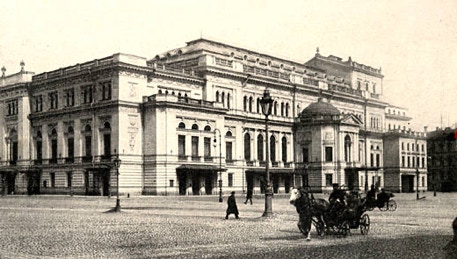
The Leningrad Conservatory of Music
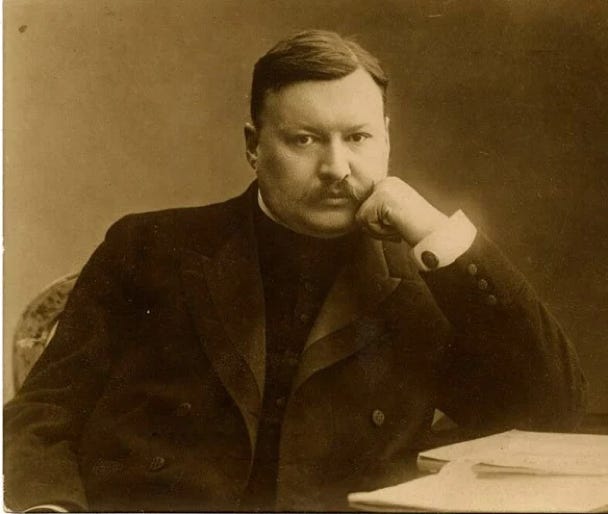
Alexander Glazunov
Then, in 1922, Shostakovich’s father, a bureaucrat in the department of Weights and Measures, perished from pneumonia. His mother had to work to support Shostakovich and his two sisters, and Shostakovich brought in extra money by capitalizing on his remarkable skill as an improviser, working as an accompanist at silent movie theaters (a task he would come to hate—he felt he was made into “a musical machine able to portray at the drop of a hat ‘happy meetings of two loving hearts’”—trite escapist fare that bore little resemblance to the realities of life in Soviet Russia). Thus, by the time Shostakovich began work on his watershed First Symphony in the autumn of 1924, the composer had been through more than usual for a young man who had just turned 18. Despite the conservatism of his professors at the Petrograd Conservatory (his main teacher was Rimsky-Korsakov’s son-in-law, who seemed determined that music history would not progress beyond about 1905), Shostakovich had already absorbed many of the young century’s musical developments. Meeting with other young musicians who had imported scores from abroad, Shostakovich quickly assimilated the new musical language being developed by Stravinsky, Prokofiev and other composers. While his First Symphony does bear traces of these influences, Shostakovich wielded them into what we today recognize as his unmistakable personal voice. Shostakovich’s style would continue to develop and mature over the course of his long career, but even in this early work his characteristic sense of humor and intensity of expression are already apparent.
The symphony was first performed on May 12, 1926 in Leningrad to tremendous success. Bruno Walter was the first conductor to conduct the work outside of Russia (in Berlin in 1926), and the Symphony quickly made its way to America, setting the stage for a career of international renown. In November 1928, Shostakovich’s First had its American premiere with Stokowski and the Philadelphia Orchestra, and later performed with Arturo Toscanini and the New York Philharmonic in April 1931. The program note for the 1928 Chicago Symphony premiere of the piece stated: “The name of Dmitri Shostakovich will vainly be searched for in the dictionaries of musical biography.” Few knew about Shostakovich before this symphony premiered, but its brilliance, its irony, and its acerbic wit set the foundation and an expectation for all the great Shostakovich works to come.
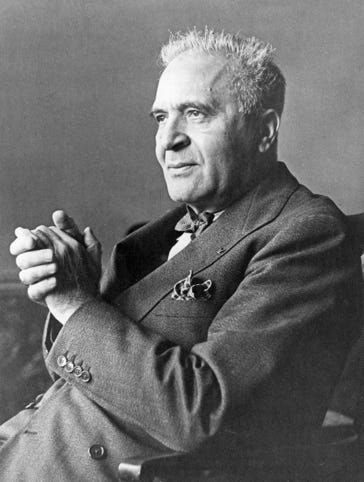


Bruno Walter
Arturo Toscanini
Leopold Stokowski
The first movement begins as a piece of chamber music for muted trumpet and bassoon, which leads to an allegro non troppo march reminiscent of the vaudeville music Shostakovich knew so well. This jaunty theme will surprise us again in the third movement. Next comes an ostensibly lyrical waltz theme. The development section, with its off-kilter mock-comic feel, features a return to the days of vaudeville. The first movement ends in the classical tradition, bringing back the opening theme. It is first realized in the flute, then in the clarinet, ending an unconventional development section with a nice bow to traditional sonata form.
First movement
The second movement is a waspish scherzo, famous for its abrupt false start in the cellos and basses. For the first time the piano is featured, in rapid scalar runs. Its alternation of refined humor and mockery recall his days playing for the movie houses, where he often laughed so uncontrollably during his favorite scenes that he had to stop playing. The slow middle section, which Edward Downes has noted ”would be marked religioso if it hadn’t been composed in Soviet Russia,” brims with uncertainty and wariness. Finally, the bassoon brings us back to the opening allegro theme; the scherzo ends with widely spaced chords from the piano and violins. It is interesting to note that after composing the first two movements, Shostakovich wrote to a friend that it would be more fitting to call the work a “‘symphony-grotesque’. I am in a terrible mood,” he continued. “Sometimes I just want to shout. To cry out in terror. Doubts and problems. All this darkness suffocates me. From sheer misery, I’ve started to compose the finale of the symphony. It’s turning out pretty gloomy.” Much like the disposition of the young composer, the grotesque feeling of the first two movements gives way to the dark feeling of the final two.
Second movement
The third movement opens with a dark theme characterized by melodic half steps —a theme not unrelated to the opening one of the first movement—which is played by the oboe and then relayed to the cello. This theme crescendos and climaxes, continuing in a deeply expressive vein that rebukes critics of Shostakovich’s supposedly inferior melodic talent. The lento finally fades away with a distant echo of the opening motif. Without pause or praise, a snare drum roll cuts the music to ribbons and propels us into the frenzied finale.
Third movement
The finale combines many previously heard themes, as well as introducing new thematic material, in a constant cross-section of furiously contrasting highs and lows of texture, timbre, mood, dynamic, and tempo which climax in a famous timpani solo. After transformation of various thematic materials from earlier movements, the finale closes with trills from the woodwinds and strings and a brilliant, albeit frantic, fanfare in the brass.
Fourth movement
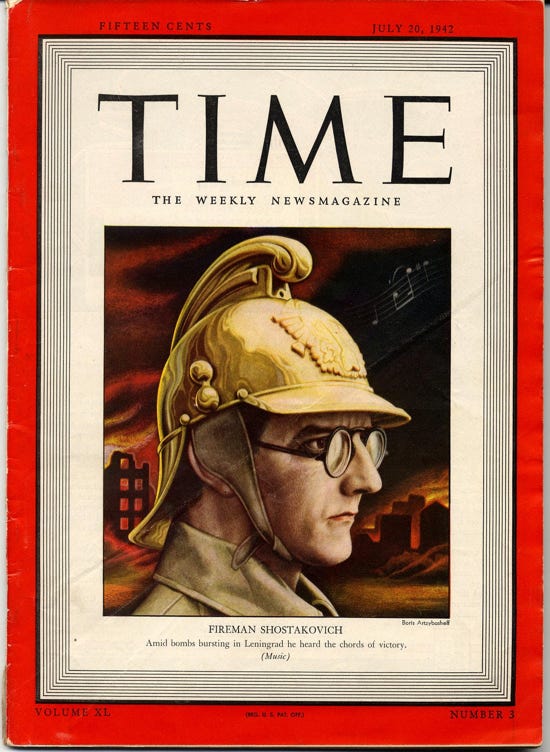
A composer on the cover of Time Magazine? Naaaah….But it is TRUE! Check out the price! After the outbreak of war between the Soviet Union and Germany in 1941, Shostakovich initially remained in Leningrad. He tried to enlist in the military but was turned away because of his poor eyesight. To compensate, he became a volunteer for the Leningrad Conservatory's firefighter brigade and delivered a radio broadcast to the Soviet people.
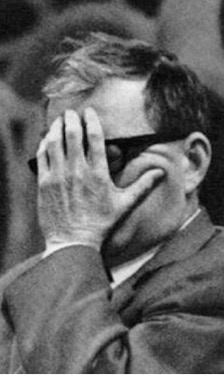
This pose seems to indicate how Shostakovich usually felt about life. This mysterious composer, who employed secret musical ciphers in his works as well as numerous quotations from composers such as Rossini and Wagner, remains an enigma. Closet dissident? Committed Soviet Party Member? Neither? One thing is certain: his music is as popular as ever-worldwide-and brings joy and meaning to millions of avid listeners.